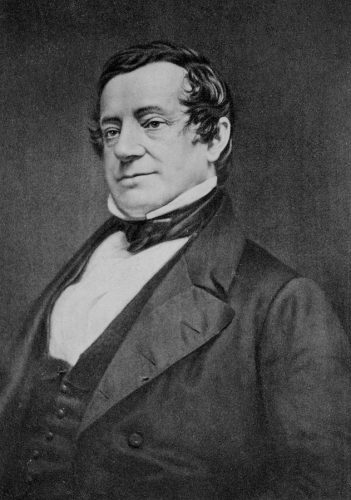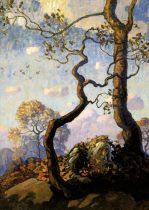
Washington Irving was born on April 3rd, 1783, in New York City, mere months before the Treaty of Paris closed out the American Revolutionary War. Six years later, when George Washington came to New York City for his inauguration, Irving received the President-Elect’s blessing. The Founding Father’s gesture turned out to be oddly prescient; the young boy who the President had just blessed later became America’s first internationally best-selling author. That being said, Irving’s literary talents took quite a bit of coaxing to reveal themselves; a young Irving proved himself utterly useless when it came to academic learning, and he received little more than an elementary school education by modern standards.
As he grew older, Irving struggled for many years to find a career that suited him; while touring Europe in 1805, Irving considered a career as a painter, and he briefly worked in the law office of John Treat on Wall Street. He even served as and aide-de-camp to Daniel Tomkins, governor of New York, during the War of 1812. Yet seeds of his later literary success littered the early period of his life; during this time, Irving published a series of satirical letters in the Morning Chronicle and worked with James Paulding and David Longworth to create a literary magazine titled Salmagundi. In 1809 Irving found his first true success as a writer upon publishing A History of New York under the assumed identity of Dutch historian Diedrich Knickerbocker.
The major turning point in Irving’s literary career arose after he moved to England in an attempt to salvage his family’s floundering trade business; while discussing his childhood in New York with his brother-in-law, Henry Van Wart, Irving fondly recalled summer afternoons spent wandering the Tarrytown area, filled with nostalgia as he remembered listening to local folk stories and admiring the scenery. Suddenly, inspiration struck, and after locking himself in his chambers and writing through the night, Irving composed an early draft of the story that would later be known as “Rip Van Winkle.” Two years later, on March 1, 1819, Irving gave a manuscript containing the first of a series of publications titled The Sketch Book of Geoffrey Crayon, Gent, to the captain of a ship to New York to deliver to his brother Ebenezer for publishing. With that, Irving’s career as a writer officially took off.

Irving’s The Sketch Book met with commercial and critical success in both the United States and England. These stories constituted the start of an American literary identity on the international stage. While Irving’s collection mainly included tales revolving around British characters and settings, it is the two American-set stories, “Rip Van Winkle” and “The Legend of Sleepy Hollow,” which received the best response.
After spending several years abroad in England and Spain, Irving returned to the US in 1832, but ten years later he was appointed Minister to Spain by President John Tyler, a position he held until 1846. Following his political career, Irving moved back to America and took up permanent residence in his home, Sunnyside, in Tarrytown, New York. During this period he published many works, including a few biographies and several essays and stories, several of which were published in literary magazines such as The Knickerbocker. Washington Irving died of a heart attack on November 28th, 1859.
Other notable works by Irving include Bracebridge Hall(1822), Tales of a Traveller(1824), Tales of the Alhambra(1832), Astoria(1836), and a famous five-volume biography of America’s first President, The Life of George Washington(1855-1859). None of Irving’s later literary works ever measured up to the initial success of The Sketch Book and the two celebrated tales that brought him his initial fame.
Works Consulted
Burstein, Andrew. The Original Knickerbocker: The Life of Washington Irving. Basic Books, 2008.
Jones, Brian Jay. Washington Irving: An American Original. Arcade Publishing, 2008.
Dutch Influence in “Rip Van Winkle”

One intriguing aspect of Washington Irving’s “Rip Van Winkle” is the author’s comparison of the somewhat fragmentary new consensus of the United States with the cultural roots that form the true axial foundation of Rip’s colloquial village: the Dutch colonists of New Amsterdam. The Dutch influence pervades “Rip Van Winkle” in nearly every aspect with a dogged persistence; “the houses of the original settlers”(Irving 27) dot Rip’s village, and the imprint of Dutch colonialism embeds itself in the landscape itself in the form of Hendrik Hudson and his crew. Even Rip himself, despite his twenty year slumber, persists within the village in the form of his son, a near-identical replication of his own youthful self. Despite the passage of time and the deterioration of much of the familiar historical architecture of the town, Rip’s face remains preserved. The perseverance of these Dutch touchstones stands in stark juxtaposition with the apparent fragility of the regions new identity as a portion of the United States, represented by the “large rickety” Union Hotel and a regal painting of King George whose “red coat was changed for one of blue” in order to change the image to one of General George Washington (Irving 35). Through this implicit assertion that post-Revolutionary union is a shallow façade, Irving posits that the Dutch hegemony that lingers from the colony of New Amsterdam is the true unifying factor which allows for the continuity of American cultural identity as Rip inherits the role of the region’s original colonists as the source of local history; the tale concludes with Rip assuming the role of village storyteller, essentially becoming the purveyor of history at the same instance that his strange story becomes local legend. Rip becomes both the conveyor and the subject of history, thus revealing Irving’s evaluation of American culture as a form of self-creation, a force that is not formed by political identity or governmental force, but rather by a shared sense of community and history which supersedes national boundaries and is geographically grounded in the American landscape.
Irving, Washington. “Rip Van Winkle.” The Legend of Sleepy Hollow & Other Stories. Dover, 2008, pp. 26-41.